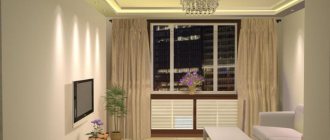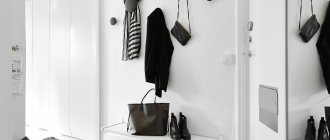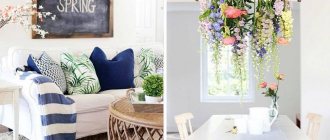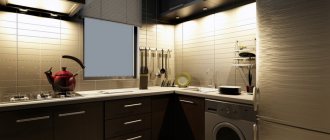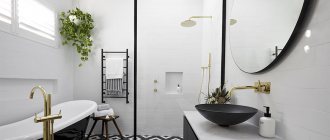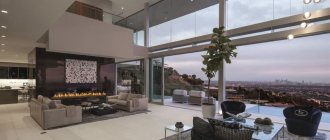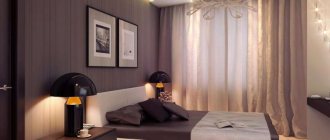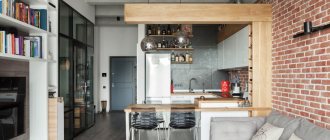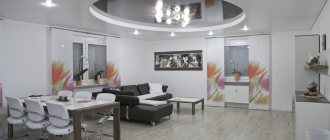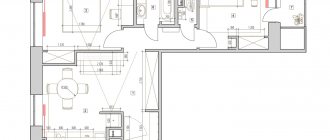Features, advantages
Such economy class housing is suitable for one young man, two students, a family without children, two pensioners, and temporary residence of a parent with a child. A studio of this size costs several times less than an ordinary one-room one, and the utility bills will be low - relatively little light, water, and heating are consumed here, since you will have to wash, heat, and illuminate a very small area. To carry out any, even the most expensive, high-quality renovation in a tiny studio, you will need much less building materials, which means the costs will be relatively low.
There will be nothing superfluous here that collects dust - it simply won’t fit here. It is important to make the most of every ledge, niche, and free corner. In such an apartment there is one window, less often two - this is quite enough to keep the room bright. There are also two doors - the entrance and the bathroom, sometimes three if the toilet and bath are separate.
Features of a small room
A cramped studio apartment has a lot of its own characteristics. The following can be distinguished from them:
- Lack of load-bearing partitions. This is acceptable when a studio is being renovated. To do this, you don’t have to collect documents or hire builders. If necessary, partitions can be installed independently.
- Open zoning. Here the arrangement of furniture is different. There are many factors to consider, the main one of which is to ensure the availability of free space.
- Such rooms are light. The lighting here is natural, as one window is enough to cover the apartment. The color and lighting of the studio are easy to choose.
In addition to the listed points, the special features include the cost of servicing such premises. Apartment 20 sq. m. cheaper upon purchase and during maintenance than a two-room or three-room apartment. This attracts people who are not willing to pay a lot, but want to ensure comfort and coziness for themselves.
There are usually only 3 doors in the room - to the bathroom, to the toilet and to the entrance. But there are exceptional moments when the bathroom is covered with a curtain. It all depends on the preferences of the owner.
When asked “how to arrange a studio?”, unlike the task of preparing a large apartment, you won’t have to look for an answer for long. Although there are many options for equipment, they are all of a typical nature.
Advantages of a small apartment
A small apartment has more positive than negative aspects. And here's the explanation.
You may be interested in: Apartment design 60 sq. m: solutions for couples and families with children
Despite the area of 20 sq. m, it is still comfortable for at least one or two people to live here. By using modernized accommodation conditions (multi-tier beds, etc.), even more people can be accommodated. This is an option for the student.
A studio costs much less than a one-room apartment. Although it is not inferior to it in area. Repairs will also not burden the owner, as they will not be expensive.
All the necessary conditions for people to live have been created here. There is a bath, a toilet, and even a place for cooking. And all this is within walking distance!
Weaknesses of the layout
No matter how many positive aspects there are, there will always be negative ones. First of all, this concerns the layout of the room.
It is not always possible to place large furniture here. Of course, you can put it there, but then there will be no free space left for other furniture. It is possible to get out of this situation only by making a global constructive decision. As an example, install partitions or change furniture to more compact ones.
The apartment has 20 sq. m. thin walls. In more expensive apartments, this problem is not always solved with the help of insulating materials.
Even when organizing a budget room design, you have to save space. This can cause a lot of difficulties. Many wishes have to be abandoned, since they are difficult to implement in such a small area.
Another drawback is the ceiling. Compared to classic housing, the height here, as a rule, is not distinguished by its high values. On average it is about 2.3-2.5 m. It all depends on the type of building.
All of the listed shortcomings are mostly easily solved or have little effect on the quality of life of the owners. Still, the positive aspects outweigh this confrontation.
Design project development
The studio's design project is quite suitable for decorating a small room in a dorm or remodeling a cramped one-room apartment. The living room is combined with the kitchen, and if there is a balcony, with it too. There is only a compact bathroom in a separate room.
Here they provide:
- the most compact, comfortable, ergonomic furniture;
- light, thin zoning elements;
- many mirrors;
- light finish;
- lack of volumetric decor.
In a room with a ceiling height of three or more meters, a second “floor” can be easily organized, where a bedroom, storage space and even an office are located. An insulated balcony is also used for these purposes.
With the help of mirrors, proper lighting, and a monochromatic light design, the space visually expands.
Options for interesting layouts to create functional areas
After purchasing or concluding a rental agreement for a studio apartment, think about the correct zoning of the premises. After all, each owner decides for himself where to place the sofa and where he will cook dinner. And for this purpose they are renovating a 20 sq. m studio. m.
Before work, you need to draw up a project. It is advisable to do it on paper. This will save both time and money. The project reflects the essence of zoning, including the arrangement of furniture.
When planning, one rule is followed: the studio has at least three zones: kitchen, bedroom and living room. There is no way without this.
You may be interested in: Transformation of an apartment of 44 sq. m. m using design and stylistic solutions
A partition or curtains are used to divide into zones. Wardrobes, sofas, etc. are often used. The role here is played by the design approach, the lot of which will depend on the features of the living space.
Furniture arrangement
As mentioned earlier, zoning can be done in a studio using furniture alone. You can use cabinets, sofas, armchairs and so on. You can furnish it with anything. Tables, tables or poufs will do.
Furniture is arranged so that the furniture fits into the room with free space to move. The best version is to use furniture of minimal size, but with greater functionality. For example, a pull-out sofa that can be used as a bed.
Arrangement of a sleeping place
At this stage of the arrangement, problems may arise. As a rule, the sleeping area in the studio is compact. A maximum of a lorry and a half can fit here. If you need a large bed, you will have to sacrifice space for another area. In this regard, the design of a one-room apartment is in an advantageous situation, since there is strict zoning.
But there is a way out of this situation. You can put a pull-out sofa, then you can save more space for the living room. Or buy a bed that fits into the wall. This will save space during the day.
The sleeping area can be equipped with separate lighting fixtures. For greater comfort, the bed can be placed by the window. But only if it is tightly sealed.
Kitchen and reception area
The least space can be allocated for the kitchen and living room areas. Kitchen for a studio 20 sq. m. should be compact and stand as far as possible from the sleeping area. An alternative is to combine the kitchen and living area.
In the kitchen, it is advisable to install a kitchen set instead of cabinets and shelves for dishes. They take up much less space and are practical to use.
There may be a bathroom next to the kitchen, but not a toilet. It will become a source of unpleasant odors, which is undesirable. Only in exceptional cases is such a layout allowed.
There is always room for household appliances in the kitchen. It is placed in the same headset or next to it. The vacuum cleaner can also be placed in the living room.
Idea for a bathroom
The bathroom is almost the main room in the house. It will not be possible to place it anywhere, because sewer pipes usually cannot always be moved where needed. Read more about a small bath and toilet.
You will be interested in: Competent layout and design of an apartment of 45 sq. m. m
Here you can change the ceiling and decoration. For example, change color or depth. Finishing comes in variable variations. To achieve results you need reliable material and technology.
Don't forget about the toilet and shower. They should not interfere with each other. The toilet and shower are placed next to each other or separated by a partition.
Color scheme for a small apartment
Colors for a small room are selected as light as possible. If this is an apartment with a high ceiling, windows facing south or southeast, cool colors are allowed. When the ceiling height is normal, and the windows face north, northwest, the space is decorated exclusively in warm colors. It is advisable to choose one or two main colors, maximum three. At least 60% of the entire room is decorated as the main one, preferably light.
The most suitable color combinations:
- beige with blue;
- pale yellow with gray;
- pink with light brown;
- apricot with beige-silver;
- snow-white with salad;
- soft purple with beaver;
- quartz with cream;
- swamp with tarpaulin;
- verdeposh with heliotrope;
- mustard with smoky white;
- pearl with white-emerald;
- canary with stone gray;
- cream with brass;
- flaxseed with lemon;
- honey with mint.
Numerous sharp contrasts in a small apartment are acceptable, but undesirable, as they visually narrow the space.
Modern finishing materials
The materials used are classic and modern. The economy option involves paper wallpaper on the walls, linoleum on the floor, whitewash or PVC tiles on the ceiling, paint on the walls, floor, and ceiling of the bathroom. For a premium class or simply a more expensive finish, parquet, boards on the floor, decorative plaster for walls, suspended ceilings, ceramic tiles in the bathroom and toilet are suitable. Less commonly used are natural and artificial stone, brick, and designer 3D wallpaper. Wallpaper with vertical stripes visually pulls the wall up, with horizontal stripes - to the sides.
The materials used for partitions are plasterboard, plywood, clear or frosted glass, fiberboard, and chipboard. Doors are made of MDF, metal, solid wood, window frames are made of metal-plastic or wood. The materials for making furniture are selected according to the chosen style: for the classic style it will be wood, stone, in the high-tech style - metal, glass, minimalism will be made of plastic, MDF.
You should not use small tiles, wallpaper with a lot of patterns, voluminous stucco molding, columns, textured stone - such decoration greatly clutters the territory of the apartment.
Space zoning
The studio layout is open space. Real interior walls take up too much space, unlike thin screens, screens, and partitions. The following zones should be distinguished in the apartment:
- bedroom;
- for relax;
- kitchen;
- lunch;
- for work;
- for storing things.
Zoning is done using:
- different colors of walls, floors, ceilings;
- screens;
- wall panels;
- translucent, thread curtains;
- partitions with built-in shelves;
- multi-level ceiling, podium;
- furniture items;
- proper lighting;
- carpet, “path”;
- arches
Separate lighting will be required for each zone plus the main, overhead lighting. Ceiling chandeliers are chosen to be strict, compact, and not clutter up the area.
Practicality, ergonomics of the kitchen area
The kitchen will occupy one short wall entirely; in a “two-story” space it will easily fit under the stairs leading to the sleeping area. Many manufacturers offer compact mini-kitchens, consisting of one or two floor-mounted, hanging cabinets, into which a sink, a horizontal refrigerator, and all the necessary appliances are built-in. The work area can be placed on an extended window sill, which will become a continuation of the set, the eating area can be behind a folding, folding, retractable bar counter that separates the kitchen space from the living room. The kitchen apron usually matches the color of the walls, contrasting with the countertop.
The area in which they eat is highlighted with light - a lamp on a long cord with adjustable height is used. The work surface is illuminated by a lamp on a rail or bracket. An LED strip is used as decorative lighting along the bottom and top of the headset. The interior space of glazed cabinets and open shelves is also illuminated.
When placing a kitchen unit along a smaller wall, the shape of an overly elongated, rectangular room is slightly adjusted. In a square apartment, the kitchen is placed to the side of the front door.
Cozy living area
For the hall, modular, transformable furniture is preferable. A coffee or compact dining table with several ottomans fits neatly under the sofa, which is integral with the wardrobe. The folding door of the latter acts as a desk.
If it is necessary to arrange an office, it is placed in a corner built-in cabinet - the tabletop extends from there, a computer and various office equipment are placed on the open shelves, and there are drawers on the sides for writing instruments and papers. Sometimes the workplace is moved to an insulated balcony or loggia, which allows you to save on lighting due to the large amount of street light.
The living area is highlighted by a sofa; it is illuminated separately by a pendant lamp and a wall sconce. The built-in closet is illuminated with LED spotlights. A narrow TV screen is placed opposite the sofa; it is hung on the wall or placed on a narrow console or shelf. The living room is also sometimes highlighted with a plain carpet - it is chosen not too small, covering the floor space right up to the kitchen, missing the walls by fifteen to twenty centimeters. For a square room, choose a round or square one, for a more elongated room - rectangular or oval.
A folding sofa may well become the only sleeping place in the apartment, then the lighting above it is preferably adjustable brightness.
Sleeping solution: loft bed
If there is sufficient ceiling height, the bedroom is organized in the “attic”. It is desirable that you can freely stand at full height under it, and sit on top without bending down. Such a bed can be made into a single, double, or one-and-a-half-size bed, equipped with sides and a comfortable ladder. Under the loft bed are placed:
- cabinet;
- living area with sofa;
- dressing room with built-in wardrobe;
- dining area;
- kitchen;
- hallway
The bed itself is equipped with a thick orthopedic mattress, and a lamp, a small shelf where you can put a watch, glasses, phone, and other small things are provided without fail. If the room is intended for an adult with a child, the staircase is made as stable as possible, with railings. The upper floor is then partially combined with the play area, having previously been equipped with handrails of sufficient height.
Disadvantages include difficulty in rearranging linen; in the summer, with a lack of ventilation, it is stuffy there. At night, getting up from there in the dark is quite problematic, and for older people with a lot of excess weight, it is unrealistic to even go upstairs.
A good solution would be to place the bed on a low podium, inside which narrow storage boxes are built. This design is suitable for a minimalist or Japanese interior. The sleeping area on the balcony will be a good solution if it is sufficiently insulated and soundproofed.
Several live potted plants on the windows diversify the interior of the studio, adding a fresh touch.
Storage space is an important point for a small apartment
A wall cabinet is placed along one wall, accommodating almost all the items found at home - outerwear, linen, books, household appliances, small sports equipment, and work tools. One of the open shelves will house a TV.
Sometimes the “wall” is replaced with a corner built-in wardrobe - decorating its doors with large mirrors significantly expands the space. Inside it is equipped with rods, pantographs, shelves, baskets for bedding, underwear, and shoes. The cabinet is equipped with drawers-organizers in which jewelry is stored, hooks for belts and ties. If space allows, a vacuum cleaner, iron, hair dryer, ironing board, and children's toys are placed in the same closet.
When there are any kind of niches in the room, several shelves are nailed into them. If you glaze such an architectural element, you will get an excellent cabinet for dishes, books, and game discs. Open and closed shelves can also be placed near the ceiling, storing things there that are not used daily. Triangular, rounded shelves in the hallway or bathroom will allow you to use all corners.
The interior space of a bed or sofa contains bedding, some linen, shoes, and children's toys. Frequently used items are hung on hooks - home clothes in the living room, hats, umbrellas in the hallway, washcloths, sponges in the bathroom, knives, ladles, towels - in the kitchen space.
The kitchen set is made high, up to the ceiling. It houses dishes, some household appliances, cutlery, towels, and napkins. If there is a kitchen corner sofa, storage space is also provided in it.
Hallway
The front door is sometimes made with a hidden frame, covered with wallpaper from the inside or decorated so as to appear invisible. Sometimes there is a corner cabinet there. This area is highlighted by a small carpet; a large full-length mirror will expand the cramped space. A vertical shoe rack will free up some space on the floor. Sometimes the hallway is separated by a through shelving or cabinet, placed with the back wall towards the corridor - this plane is decorated with narrow shelves for small items, rag organizers, and covered with wallpaper or colorful posters. Separating the corridor from the rest of the room with curtains is also acceptable, but they must be well combined with carpets, window curtains, and furniture textiles. Here, a mirror, hanger or closet is locally illuminated; a lamp above the door is possible.
Functional bathroom
A shared bathroom is three to four meters long, a separate one is allocated one and a half to two “squares” for the toilet, two or three for the bathroom. The walls of these premises are covered with special moisture-resistant wallpaper, the floor is laid with light large tiles without a pattern. To save space, a full-fledged bathtub is replaced with a shortened, corner or shower stall. If there is a bathtub, storage space is placed under it, hanging shelves for detergents and cosmetics are located above a narrow washing machine, if it is decided to place it in the bathroom. There is lighting here above each plumbing fixture and mirror. To create greater decorativeness, an LED strip is installed along the floor and ceiling.
Zoning of the kitchen-living room 22 sq m
A room that combines several diverse functional tasks should be visually divided into thematic areas. The kitchen-living room is a complex of working, dining and relaxation areas.
The part of the room intended for culinary manipulations can be limited to 5 square meters. meters. By the standards of designers, this is quite enough for most housewives. Of course, if the room is designed for cooks who treat cooking with passion and passion, additional space should be allocated for household appliances, kitchen utensils and cutting surfaces.
The remaining space is designed as a cozy corner for receiving visitors and relaxing for household members. Zoning a room can be done using the following design moves:
- use of furniture. A dining table or an elongated soft sofa serve as a very specific delimiter of the kitchen space. Such thematic zoning does not require additional methods of division. Also, shelving, screens, and a bar counter can be used to symbolize different areas of the room;
- differentiation of finishes. The use of materials of different textures can also serve as a delimiter between the kitchen and living room into different zones. The practical option of finishing the flooring near the work area with tiles, and in the rest of the room with laminate or parquet, is widely used. Carpeting can also act as a delimiter. The apron and walls near the kitchen unit are covered with washable wallpaper, ceramics or plaster. Materials that contrast in texture are used to decorate the dining and guest areas. Another interesting move is the step separating the kitchen from the living room. Objects located on a kind of podium are visually separated from the rest of the room. Also for zoning the kitchen-living room 22 sq. meters, designers widely use plasterboard structures. These can be partitions, arches, drops in suspended ceilings;
- lighting. Placing different types of lamps in separate parts of the room will immediately make it clear where the boundaries of the zones lie;
- color scheme. Dividing a room into zones can be done using different tones in surface finishes. A light kitchen set, a wooden dining table and a bright, rich sofa for guests will clearly define the functional boundaries in the room.
Stylistic directions
Styles that require a large amount of volumetric decor, carved furniture, and free space are unacceptable here. The apartments provide only the most necessary furnishings, household items, and various equipment.
Most suitable solutions:
- minimalism - only the most necessary furniture, simple shapes, mostly monochromatic decoration, practically no decor, built-in household appliances;
- Scandinavian - wood or ceramic tiles on the floor, light, multifunctional furniture with individual bright accents in cool shades;
- Provence – light floor, ceiling, walls, floral prints on textiles, simple wooden furniture, the bedroom is separated by a curtain. It is acceptable to have “cozy” accessories, paintings, watches;
- ethnic - floorboards or tiles on the floor, coarse linen fabric or its imitation on the walls, furniture made of untreated wood, yellow-brown color scheme;
- Japanese - low furniture, an almost invisible kitchen set, a bed on a podium or closet, a carpet-mat in the middle of the living room, a ceiling made of plain plasterboard;
- high-tech - an abundance of silver, steel surfaces, glass countertops, zoning screens, metal blinds, many different light sources, a dark plain carpet on the floor, ceramic tiles;
- loft - imitation brick-like wall decoration, high ceiling with open beams, laminate flooring, panoramic windows without curtains, floor hangers, dark contrasting elements are allowed;
- Art Deco - velvet-look wallpaper, parquet flooring, hand-painted and leather upholstery on furniture, a lot of gloss, mirrors, animal skin or its artificial imitation instead of carpet in the living room, sleeping area, heavy curtains;
- classic - the main color of the interior is gray or beige, the furniture is exclusively wooden, has forged parts, is of good quality, bright textiles and an imitation fireplace are allowed;
- art-believe - there is plain wallpaper on the walls, the ceiling is whitewashed, there are rugs knitted from old knitwear on the floor, homemade furniture from boards, Euro pallets, painted with light paint.
Having chosen a certain style, it should be followed throughout the entire apartment. This applies to floor, wall, ceiling coverings, window, door and furniture design.
